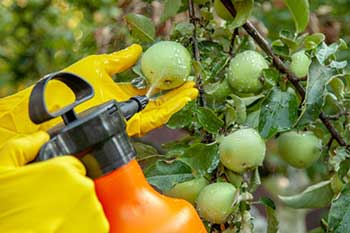Fruit Pests & Disease Control
Prevention is better than cure
Pests and diseases can be managed through adopting good growing practices, planting resistant varieties and using low-toxicity, environmentally-friendly products.
The organic gardening philosophy is to let nature take its course and for all organisms to live in balance – this requires acceptance of a level of pest and disease damage.
Most gardeners, however, understandably want to harvest good crops relatively free of pests and disease that are grown in a safe and environmentally sustainable manner.
The following methods may help guide you, our home gardeners, to ways of pest and disease control that best suits your needs, taking into account:-
- Good yields, relatively free of pests and diseases.
- Using best garden practices to minimise pests and diseases.
- Using only safe environmentally friendly products.
- Using products that are commonly available in home garden size packs and are legally registered for the purpose stated.
Common diseases to pipfruit such as apples, pears, nashis, include:
Common diseases of stonefruit:
Common diseases of citrus fruit:
Using Good Gardening Practices
Using good basic gardening practices to minimise pests and diseases is common to all gardeners, whether conventional or organic. In simple terms—providing the best growing conditions to ensure a strong healthy crop.
The following are the simple basics:
- In heavy soils, raise the planting area above the surrounding soil to ensure good drainage, add in some Gypsum to improve airation and drainage in the soil.
- Add lots of compost and work into the soil.
- Mulching with compost, grass clippings (free from any spray residue), or straw holds in moisture and improves soil structure.
- Provide adequate balanced feeding—sheep manure pellets or a fruit tree fertiliser.
- Provide good deep watering in dry periods.
- Practice good garden hygiene by removing all diseased leaves and plants.

Using Disease-Resistant Plant Varieties
Whilst a few ‘Heritage’ varieties may have disease resistance, there is a range of modern varieties likely to be better. Using disease resistant varieties will ensure better crops and greatly minimise the need to use fungicides.
If you're unsure of what variety would be best suited to your area and be resistant to disease, pop in to your local store and ask us! We're happy to guide you in the right direction.
Using Biological Controls
Biological control involves using another living organism to attack the bad one. This is becoming common with commercial growers, but these organisms are not available to home gardeners.
What can be done as an alternative, however, is to use only pesticides that are soft on desirable insects such as bees, ladybirds and predator mites and harsh on the ones you need to get rid of.
One example is a Codling Moth Trap.
Using Pesticides
If good gardening practices are followed and disease resistant varieties used, the use of pesticides can be minimised.
There is a range of very low toxicity, environmentally-friendly pesticides available to home gardeners.
Be aware that some pesticides are toxic—both chemical and natural organic. Being natural organic doesn’t necessarily make it safe.
Pesticides also vary greatly in effectiveness. Whilst organic pesticides are usually safer (but not always) they are generally less effective.
Synthetic pesticides approved for home garden use are very low in toxicity compared to commercially available pesticides. So much so, that they are often less toxic and more environmentally friendly than an organic equivalent.
Prevention is better than cure.
Once you have gained experience and are aware of what pests and/or diseases attack which crops, you will be able to anticipate and spray at the first sign, which is more effective and minimises pesticide use.
Follow recommended spray programmes for each type of fruit, especially the early season, preventative sprays.
Always read the label
- The label is a legal document for registered pesticides.
- Take normal precautions when handling concentrates during mixing.
- Wash hands thoroughly after using.
- Store out of reach of children.
What to Use
Fruits are susceptible to attack from a greater range of pests and diseases than vegetables.
There are also a number of complicating issues:
- Different pests and diseases attack different fruits.
- Most pesticides are only approved for use on some fruits.
- There is also significant variation in the effectiveness of pesticides.
- Withholding periods also vary between pesticides and between different fruits.
There are generally three choices for which type of pesticide you can use — ‘organic’, ‘environmentally-friendly’ or other pesticides approved for use.
Withholding Period
The NZ Food Safety Authority has set withholding periods for each pesticide, and particular crop.
The withholding period is the period that must elapse between spraying and harvesting, and is on the label of each product.
Most home garden pesticides have withholding periods of 3 to 14 days. Always check the label.

7674